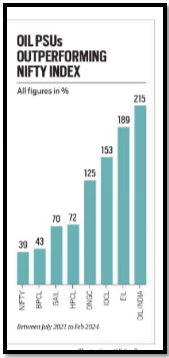TRANSFORMATIVE LEADERSHIP:PSUS
Syllabus:
GS-3 :Public sector enterprises and their role, Disinvestment in various sectors
Focus :
- The focus area of the article is the transformative leadership of the Modi government in revitalizing Public Sector Enterprises (PSEs) in India. It highlights the government’s strategic approach, emphasizing accountability and performance, leading to improved financial health, profitability, and strategic investment in PSEs. The article also contrasts the current regime’s achievements with the mismanagement of PSEs during the previous regime.
Source - IE
Performance of Public Sector(PSEs):
- Data from fiscal year 2023-24 reveals exemplary performance by key PSEs like Oil India Ltd, 10CL, BPCL, Coal India, and NTPC.
- Achievements include record-high production, throughput, sales volume, and profits across various sectors.
Contrast with Previous Regime:
- Under the UPA regime, PSEs were mismanaged and used for personal gains, leading to inefficiency and corruption.
- Modi government’s leadership ushered in a new era of accountability and performance-driven culture in PSEs.
Freedom with Accountability:
- PM Modi’s approach balances freedom for PSEs with accountability, enabling them to compete globally while remaining aligned with national objectives.
- Government maintains an arm’s length distance, fostering a culture of responsible corporate citizenship.
Financial Health and Profitability:
- Despite keeping fuel prices low, oil PSUs posted substantial profits, contributing significantly to the economy.
- Profits enable higher tax revenues, dividends to the government, and investment in future projects.
Market Capitalisation and Investment:
- Market capitalisation of oil PSUs and upstream companies doubled in the last three years, reflecting investor confidence.
- PSEs are implementing and completing strategic projects with significant long-term investment.
Selective Divestment Strategy:
- Government’s approach to divestment is nuanced, considering each PSE’s unique strengths and strategic importance.
- While Air India was divested due to losses, retaining control of BPCL was deemed crucial for its contributions to energy transition and profitability.
Eligibility for a Maharatna company :
Strategic Disinvestment : In order to implement strategic disinvestment, the government would need to transfer management control and sell a sizable portion of its up to 50% stake in a central public sector enterprise (CPSE), or a larger percentage as determined by the relevant body. Government’s Disinvestment Strategy :
|
Success Stories and Sustainable Growth:
- Gujarat’s state-run electricity boards, under Modi’s leadership, achieved profitability through efficient management and reforms.
- Modi government’s stewardship signifies a shift towards professionalism, strategic planning, and alignment with national interests.
Source:Indian Express
Mains Practice Question :
GS-3
“Discuss the transformative impact of the Modi government’s leadership on the performance and governance of Public Sector Enterprises (PSEs) in India, highlighting key achievements and strategic initiatives?” (250 words)




